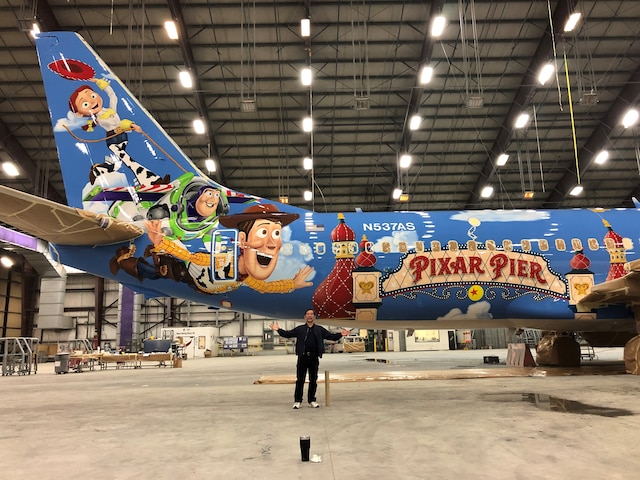Imagine being able to create flying works of art. Dazzling designs that can turn the skies into a soaring showcase of aeronautic creativity.
It’s a tough job, but somebody has to do it. However, if you ask Michael Suhara to describe his role at AkzoNobel, he’ll cryptically tell you he’s the Senior Technical Service Coordinator for Aerospace Coatings. That doesn’t even tell half the story.
Fast closing in on 30 years with the company, he’s our go-to person for Boeing when it comes to developing new products that meet their strict specifications. That’s a huge responsibility in itself, but Michael also takes care of another area of the business – he oversees the collaborative process behind the eye-popping liveries that are regularly applied to aircraft using our high-performance products.
Works of art
And that’s where his decades of experience in aerospace coatings take on another dimension. Because over the years, Michael (who’s based in Seattle in the US), has honed additional skills as an artist and designer – which comes in quite handy when you’re helping customers turn aircraft into flying works of art.
The many and various projects he’s worked on include Star Wars and Toy Story themed liveries for Alaska Airlines. Which obviously invites comments that he’s taking customers to infinity and beyond. And that’s closer to the truth than you might think, because as far as Michael is concerned, he’s laser-focused on ensuring that every customer gets exactly the colors they’re looking for.
“The thing about paint is that it’s usually the last thing people think about, but it’s the first thing you see,” says Michael, who used to paint the stunt planes flown by Bob Hoover, widely considered to be one of the founding fathers of modern aerobatics.
Partnering with customers
His main involvement with the special liveries revolves around partnering with customers to determine the perfect colors and agree on how they’ll be applied. “We always invite our customers and their designers to our Troy site, so they can meet with our color experts to ensure they end up with the precise colors they want,” Michael continues.
“The Toy Story plane is a great example. Disney is very particular when it comes to color, so we wanted to make sure that if you go to Pixar Pier at Disneyland Resort, the colors you see will be exactly the same as the ones on the Alaska Airlines plane we coated.”
More often than not, Michael is there when the planes are being sprayed – watching, advising and ensuring that everything goes as smoothly as possible. “I usually get involved after they’ve stripped down the airplane and applied the primer and basecoat. Sometimes you have to do things on the fly and make small adjustments, but mainly I’m there to finesse things, modify if necessary and help the customer achieve what they need to do.”
Once nicknamed Jimmy Neutron after making up a color on the spot to fix an issue with a UPS livery, Michael adds that it’s a complex process, now made somewhat easier by continuous advances in computer technology.
Science and technology
“When you apply a design to a fuselage, there are lots of things to consider, such as the multiple compounds and all the various curves and contours. That’s why working closely with designers and applicators is so important. People who can visualize design concepts on aircraft are rare, because it takes someone with a little bit of a bent mind to actually understand how it all works. But now, with computer technology improving all the time, it's become much easier.”
And such are the relationships that he’s built up over the years, some customers no longer have to think twice when they need a customized design. “When Alaska wants to do a special livery, they come straight to us,” notes Michael. “It’s the same with Southwest Airlines, who really like our Aerodur basecoat/clearcoat system.”
He’s quick to point out, however, that it requires a big team effort. “There's hundreds of people behind me that make me look good. Over the years, I’ve had the pleasure of working with lots of great people, and they’ve taught me many things that I apply to what we do today.”
Aviation innovation
With technology constantly changing, new ways of working are inevitable. One of the most recent developments in aircraft art is the use of inkjet printing to apply designs. “Inkjet printing is really light, because it’s extra thin, but the ink can fade quickly,” Michael continues. “What we’ve found is that it works best in combination with our products. It’s applied on top of our Aerodur 3001 white basecoat, then they paint over it with our Aerodur 3002 clearcoat. Which basically means they can put any picture on the side of a plane. How exciting is that?
“It’s just another great example of how we’re painting the future – finding new ways that our products can be used and applied. Working for AkzoNobel, I’ve experienced numerous changes over the years, as we’ve continued to develop and integrate next generation technologies. And who knows where we’ll go next? I can’t wait to find out.”

Inspired by Michael’s story?
Take a look at the opportunities we have for a career in aerospace coatings.







